Burgundy’s Wealth Of Riches: Shopping List Of Thirteen Packages Of Red ‘Premier-Cru vs. Village’ Pairs To Gift Wine Lovers, Or Explore. Thirteen Intrepid Producers In Thirteen Côte-d’Or Communes.
We can accept that each plot of land on earth is handed a certain microclimate, and whereas climate change may alter some aspects of its character, an acre’s terroir is written in stone… and soil, and elevation, and exposure. But it is very much a human endeavor to make the most of every hand we are dealt, and as such, although the complex and highly-specific Burgundian classification system rarely offers upgrades for loyal service, the efforts of winemakers, combined with changing weather patterns, often raises the bar in areas deemed Village-level rather than Premier Cru to create wines that are superlative.
In this week’s overview, we will take a look at the similarities and differences in a few familiar names when they set their mind to producing a bottling from various hallowed plots of Burgundian territory, both Village-designated and those that wear the Premier Cru label.
Take advantage of these Holiday Packages to explore and discover; treat yourself to a unique opportunity to try several of these appellations—Village level and Premier Cru level—side by side, or gift an example to a wine-lover among your circle of friends and family.
The Notion Of Terroir: Earth Is Given Voice
Above all, terroir is a concept; a flight of vinous fancy that insists a wine’s taste and aroma reflect its place of origin. This reflection may be subtle or overt, but there’s plenty of science behind it. Terroir includes specific soil types, topography, microclimate, landscape characteristics and biodiversity—all features that interact with a winemaker’s choice of viticultural and enological techniques.
Every square foot of earth that supports a vine has its own unique terroir, and wine appreciation is founded on the principal that not all terroirs are created equal. Thus, we find the hyper-division of vineyards sites from the most broad to the narrowest—some named climats are only a few rows in size, but produce wine markedly different than their neighbors. In Burgundy, this obsession with small, precisely delimited parcels is probably more defined than anywhere else, and we will always seek out the best of those wines and share as much information about the vineyards as we can unearth… pun intended.
Decoding The Burgundy Hierarchy
Nowhere does terroir count more blatantly than in Burgundy’s classification system, which has four distinct levels, Grand Cru, Premier Cru, Villages and Régionale, divided up into 84 separate appellations.
Grand Cru, the top of the pyramid, represent less than 1% of the region’s total production. All of the white Grand Crus are today found in the Côte de Beaune, while all of the red Grand Crus (with the exception of the Corton family) are found in the Côte de Nuits. To be consistently exceptional requires exceptional strictures; besides being the favored sites geographically, Grand Cru wines are made with a specified grape variety from a regulated patch of land, from vines of at least 3 years of age and below a certain maximum yield per unit area of land.
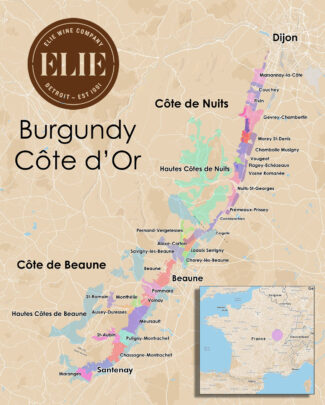
Premier Cru wines account for another 5% of Burgundy’s total production, and as such, is only a slightly larger drop in the bucket. There are a few that may outperform Grand Cru wines, but they are priced accordingly. The majority of Premier Crus are from named vineyards, and the climat name will appear on the label. For example, Puligny-Montrachet Premier Cru Les Folatières assures you that this wine comes from the Folatières vineyard in the village of Puligny-Montrachet.
Village level wine is a broad and encompassing swath of terroir recognition, but it is undeniably describable: Savigny is meaty, Volnay is elegant, Vosne-Romanée is spicy, Meursault is nutty. Wines at this level have a slightly higher allowed yield per hectare, but the varietal requirements are the same. This is a slot where Burgundy’s best bargains fit; any vineyard site, Grand Cru or Premier Cru can go into a bottle labeled only after a village. Although it might sound counter-intuitive for a domain to do this, it isn’t. Wineries declassify Grand Cru and Premier Cru wines frequently, and for a variety of reasons.
Régionale wines represent the bulk of wine produced in Burgundy; they are generic, have much more relaxed standards for yields and grape types. They may be labeled Bourgogne Rouge, Bourgogne Blanc, Bourgogne Pinot Noir, Bourgogne Chardonnay or Bourgogne Aligoté—even Bourgogne Passtoutgrains, which is Gamay mixed with a lower percentage of Pinot Noir.
Côte de Beaune
A Myriad Of Soils And Microclimates
A mnemonic device for remembering which shade of wine is best represented by the two subdivisions of the Côte d’Or, the Côte de Beaune and the Côte de Nuit: Bones are white, and the greatest of the Chardonnay-based white Burgundy (Corton-Charlemagne, Montrachet, et al) are from Beaune. Night is dark, and the greatest Pinot Noir-based reds (La Romanée-Conti, Chambertin, et al) come from the ‘Night Slopes’—the Côte de Nuit.
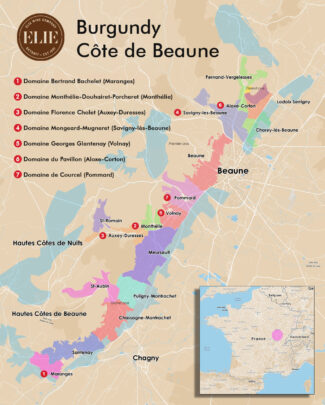
Of course, the two regions make wines of either color. The Côte de Beaune is the southern half of the Côte d’Or escarpment, hilly country where, like the bowls of porridge in Goldilocks, the topsoils near the tops of the elevation are too sparse to support vines and, in the valleys, too fertile to produce top quality wine. The Goldilocks Zone (the mid-slopes) are where the Grand and Premier Cru vineyards are found, primarily at elevations between 720 and 980 feet. Drainage is good, and when vines are properly located to maximize sun exposure, the greatest Burgundies thrive and produce, year after year. The lesser, often forgettable Burgundies (generic Bourgogne) comes from the flatlands beneath the slopes; the fact that these wines are also made from Pinot Noir and Chardonnay is indication of why terroir matters. Likewise, the narrow band of regional appellation vineyards at the top of the slopes produce light wines labeled Bourgogne Hautes-Côtes de Beaune.
$91 Maranges Village vs. Premier Cru
f the name ‘Maranges’ (at the southern tip of the Côte de Beaune) strikes you as unfamiliar, it’s understandable: It has only existed as a stand-alone appellation since 1988 and encompasses the three villages of Cheilly-lès-Maranges, Dezize-lès-Maranges and Sampigny-lès-Maranges, just west of the more well-known village of Santenay. It is situated in storybook countryside referred to by Burgundian writer Henri Vincenot as ‘gentle and warm-hearted, where the old-fashioned homes of the winemakers provide perfect subjects for a painter’s brush.’
Unlike much of the Côte de Beaune, the slopes of Maranges have a southerly to south-west exposure, although the make-up of the soil is nearly identical. Cheilly, in the valley of the Cozanne, has rather light pebbly soils while the climats of Sampigny and Dezize to the south of Santenay lie on brown limestone soils and limey marls. A handful of these are classified as Premier Cru, including Clos de la Boutière, Clos de la Fussière, La Fussière, Le Clos des Loyères, Le Clos des Rois, Le Croix Moines and Les Clos Roussots. Peppering these prime spots are numerous lieux-dits.
In general, the production is red, but Chardonnay plantings are on the upswing. The reds are fruit-laden and show blackcurrant and spiced—even preserved—red fruits, often tinged with licorice. The whites, still somewhat rare, offer hawthorn, acacia and honeysuckle when young, and with age, showcase notes of gunflint and honey.
Domaine Bertrand Bachelet
Fourth generation in a line of Burgundy winegrowers, Bertrand took over from his father Jean-Louis in 2012, working 32 acres stretching from Maranges to Pommard. The estate itself is located in Dezize-lès-Maranges, which accounts for the greatest percentage of Bachelet’s production.
“I have always been passionate about our family tradition of producing high-quality wines, but I have opted to employ new techniques that come from modern viticulture and oenology, all with an aim of drawing the best from each terroir. My foremost emphasis is on the meticulous work in the vineyard required to grow healthy grapes. From the pruning stage right up to the harvest, all work is done manually.”
He adds that vinification is still carried out in a traditional manner with little intervention, to highlight the uniqueness and complexity of the region.
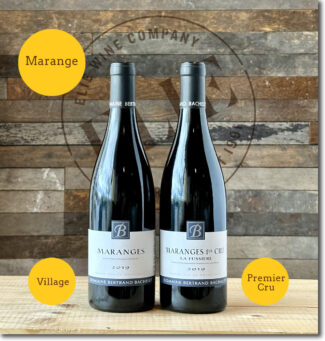 Domaine Bertrand Bachelet, 2019 Maranges ($41)
Domaine Bertrand Bachelet, 2019 Maranges ($41)
Bechelet’s Village-level wine comes from two localities, Aux Artaux and En Crevèches, both situated in the Cheilly-lès-Maranges area. Bertrand considers this a wine to reach its peak within a few years of harvest; it is particularly aromatic, with a nose reflecting raspberries, blackcurrants and candied cherries.
Domaine Bertrand Bachelet, 2019 Maranges Premier Cru La Fussière ($50)
Located in the Cheilly and Dezize-lès-Maranges, La Fussière is the main climat of the Maranges appellation. It is planted 100% to Pinot Noir on clay, marl and limestone rocks. The grapes for this wine are rigorously sorted before being partially or totally destemmed; vatting lasts for about three weeks, with regular temperature controls. Extractions are done with very little intervention beyond pigéage and rémontage. The wine is aged for one year followed by several months in vats to stabilize the wine before bottling. The concentration of 50-year-old vines is evident in the wine’s refined texture and sustained finish where notes of black tea and fresh leather mingle with black cherry, wild raspberry and currant.
$115 Monthélie Village vs. Premier Cru
Author Pierre Poupon describes Monthélie as being “…prettily nestled into the curve of the hillside like the head of Saint John against the shoulder of Jesus. Monthélie resembles a village in Tuscany.”
The appellation is home to 15 Premier Cru climats concentrated in one area to the east of the village, bordering the more prestigious vineyards of Volnay. A rose is a rose, but not all Premier Cru sites are created equal, and traditionally, those of Monthélie are not considered among Burgundy’s finest. Classic Monthélie wines are similar to those of neighboring Volnay (the villages are only a mile apart) but are not quite as full flavored or elegant, but they are generally considered to be superior to the red wines of Auxey-Duresses, also just a mile away in the other direction. Again, these are ideal terroirs to stir in a little extra warmth via global warming and follow the improvements with a corkscrew and glass.
Domaine Monthélie-Douhairet-Porcheret
The triumvirate of names each has its own special significance to the estate. Named first for the 300-year-old southern Burgundy village in which it is located, Monthélie-Douhairet was run by the Douhairet family for many years. In the early 1970s, the two sisters Armande and Charlotte Douhairet inherited the vines and decided to separate; Armande fought to keep her share while Charlotte sold hers. Then, in 1989, Madame Douhairet asked renowned winemaker André Porcheret to take charge and subsequently, added his name to the domain.
André Porcheret has been one of the great figures in Beaune; prior to overseeing Domaine Monthélie-Douhairet he was the cellar manager at the Hospices de Beaune, then worked for Lalou Bize Leroy to make wines at the newly created Domaine Leroy—whereupon, he returned to the Hospices de Beaune for another five-year stint. Today, with his granddaughter Cataldina Lippo, he produces wines on M-D-P’s fifteen acres that are classic, elegant and true to the terroirs of Pommard, Volnay, Meursault and Monthélie.
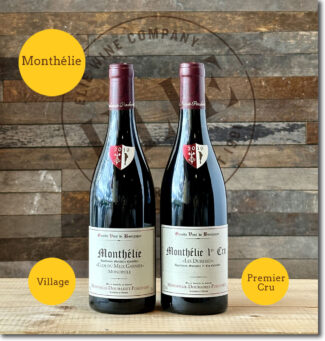 Domaine Monthélie-Douhairet-Porcheret, 2019 Monthélie ‘Clos du Meix Garnier’ Monopole ($46)
Domaine Monthélie-Douhairet-Porcheret, 2019 Monthélie ‘Clos du Meix Garnier’ Monopole ($46)
‘Clos du Meix Garnier’ is a vineyard entirely owned by the estate—making it a monopole. From these three acres, about 8000 bottles are produced annually; the grapes are 100% de-stemmed and treated to gentle, old school fermentation and maceration before being aged for 18 months in barrels (10% new). Aromas of blood orange, raspberries and plums introduce a satiny wine with tangy acids and chalky tannins.
Domaine Monthélie-Douhairet-Porcheret, 2019 Monthélie Premier Cru Les Duresses ($69)
The 16 acres of Les Duresses is the only Premier Cru vineyard on the western side of Monthélie between Volnay and Meursault. Les Duresses is planted to 82% Pinot Noir, although there is some Chardonnay on the upper slope. Soils are pebbly marl with a good proportion of clay, especially lower down the slope. Argovian (Jurassic) limestone provides the minerality for which these wines are famous. The wine displays a depth a similar depth to the Meix Garnier, but is fruitier, like ‘Miss Armande’. There is more muscle, too, with raspberry and strawberry notes showing above slight oak and leading to a lengthy finish.
$129 Auxey-Duresses Village vs. Premier Cru
There was a time when the wines of Auxey-Duresses were sold under false premises—the reds were named Volnay and the whites, Meursault. In fact, experts could easily tell the difference. Yet, the differences have begun to evaporate as a new generation of winemaker in the appellation, coupled with a changing climate, has realized that Auxey-Duresses grapes may have the breeding to rival their hallowed neighbors without the need of fraud.
The first obstacle they had to overcome was geography. Unlike Meursault and Volnay, Auxey-Duresses vines cling to a variety of high slopes and have traditionally produced a hard red wine that is frequently sold to négociants for Bourgogne Rouge blends. But with patience, these same grapes, when bottled at estates within the appellation, improve immeasurably and become silken gems that may rival nearby powerhouses at a fraction of the cost.
Likewise Auxey-Duresses whites that may initially produce the hazelnut whiffs familiar to fans of Meursault, are beginning to produce wines of increasing depth that improve exponentially in the cellar. The warmer weather has been a godsend to intrepid vignerons who have raised the value of Auxey-Duresses far beyond its current price tag.
Domaine Florence Cholet
The Platonic idea of this package’s theme may be Domaine Florence Cholet, an estate formed Florence’s father Christian in 1976 (as Domaine Christian Cholet-Pelletier) who was joined in 1982 by his wife Anne. Located in the tiny village of Corcelles-les-Arts east of Puligny Montrachet and directly across from Meursault, the 18.5 acres of marl and limestone are planted to 75% Chardonnay and 25% Pinot Noir; vines range from 25 to 75 years old and the estate bottles about 1400 cases per year.
Having gained work experience across France (Chapoutier), the United States (Walla Wall, Washington) and Australia, daughter Florence studied biology and biochemistry at the University of Burgundy in Dijon where she earned a license in viticulture and a Master’s degree in oenology. In 2019, she returned to Corcelles-les-Arts to take over the estate from her parents, renaming it Domaine Florence Cholet. Among the innovations she brings to the domain is a policy against herbicide and pesticide; she ploughs by horse and allows natural fermentation on native yeasts. New oak is used sparingly at a maximum of 25% and wines are bottled using only a minimum of filtration.
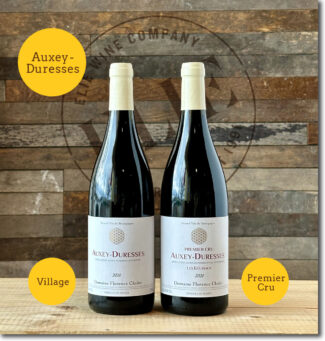 Domaine Florence Cholet, 2020 Auxey-Duresses ($61)
Domaine Florence Cholet, 2020 Auxey-Duresses ($61)
From 60-year-old vines grown between Meursault and Monthélie; Cholet’s penchant for gentle pressing and prolonged fermentation makes this a modern-style Burgundy filled with freshness and perfume. On the palate, there is cranberry crunch with wild strawberries and a touch of dried herb.
Domaine Florence Cholet, 2020 Auxey-Duresses Premier Cru Les Ecussaux ($71)
Les Ecussaux is a Premier Cru vineyard on the Montagne du Bourdon, just to the east of the Auxey-Duresses village, between the roads to Beaune and to Meursault, whose junction forms its most westerly point. To the north lie the Premier Crus Les Duresses and Bas des Duresses. The wine displays firm tannins, crisp blackberry and mulberry, a touch of white pepper and a fleshy finish.
$130 Savigny-lès-Beaune Village vs Premier Cru
Chances are, you love wines from the Rhine and are passionate about wines from the Rhône, but at first glance, ‘wines of the Rhoin’ may look like a typo. In fact, this small river flows from the cliffs of Bouilland through the commune of Savigny-lès-Beaune, and alluvia from the overflow adds fertility to the lower slopes of the hills of Beaune. With nearly nine hundred acres of vineyard, the appellation is one of Burgundy’s largest.
Savigny’s terroir features a gentle gradient that becomes steeper as the altitudes approach 1300 feet, where the geology is similar to that of the great Grand Cru hill of Corton. Favored exposures face the south, where the soils are gravelly and scattered with oolitic ironstone. Near the river valley, the red-brown limestone becomes more clayey and pebbly, while the east-facing slopes consist of sand and limestone.
As rich in history as it is in Premier Cru vineyards (there are 22), Savigny-lès-Beaune was once a social hub where the nobility and clergy rubbed shoulders, and the near mythical regard for the quality of its wine is reflected in a stone carving on a Savigny château: “The wines of Savigny are nourishing, theological and keep death at bay.”
Domaine Mongeard-Mugneret
The name ‘Mongeard’ first makes an appearance in Burgundy in 1786, where records show a Mongeard working as vigneron for Domaine de la Romanée-Conti. Skip forward to 1945, when at the age of 16, Jean Mongeard (whose mother was from Famille Mugneret) made wine which he sold by the barrel to négociants. The entire 1945 crop was purchased by Baron le Roy, Marquis D’Angerville, and Henri Gouges, who suggested that the young Mongeard start bottling the wines himself.
In 1975, Jean’s son Vincent began working alongside his father and became responsible for viticulture and vinification of the domaine’s wines. He persuaded his father to return to the traditional method of bottling without filtration and filtering only in certain vintages. Upon his retirement in 1995, Vincent assumed complete leadership of the domain, which now covers more than 75 acres split among 35 appellations.
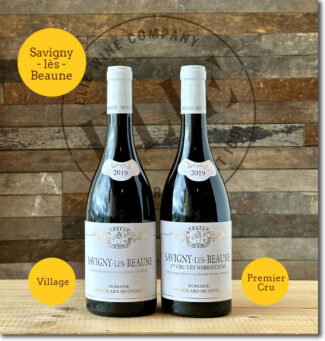 Domaine Mongeard-Mugneret, 2019 Savigny-lès-Beaune ($58)
Domaine Mongeard-Mugneret, 2019 Savigny-lès-Beaune ($58)
From vines with an average age of 36 years, the wine sees around 15% new oak. Youthful and intense, this brilliant ruby-colored Pinot displays characteristic aromas of spice and violet mingled with wild blackberry; nice length and elegance.
Domaine Mongeard-Mugneret , 2019 Savigny-lès-Beaune Premier Cru Les Narbantons ($72)
From their 8.4-acre parcel in Les Narbantons, Vincent Mongeard drew from vines more than a half century old, hand harvesting and sorting the grapes, then aging the wine in 30% new oak. The wine shows a deep and complex bouquet of cassis, fresh wild berries, wood smoke, cola with some hazelnuts and citrus rind. A muscular mouthful, it’s layered with powdery tannins, lively acids and a long, sapid finish.
$153 Volnay Village vs. Premier Cru
No red wine appellation is more synonymous with ‘perfume’ than Volnay; the wines have historically checked all the boxes for quality, vigor and longevity but with an aromatic delicacy traditionally referred to as ‘feminine.’ The appellation has existed since 1937, and is reserved for Pinot Noir-based red wines exclusively. Although the region contains no Grand Crus, more than half of the vineyards covered by Volnay’s 526 acres are rated as Volnay Premier Crus. Just across the boundary that delimits Meursault, Volnay-Santenots is grown on terroir better suited to Pinot Noir than Meursault’s legendary Chardonnay.
The appellation stretches across a narrow band of oolitic limestone on the hill of Chaignot, with vineyards facing south-east. At the top of the slope, the soil is pink in color with pale green inclusions overlain by schist. As the ground descends, white, chalky-textured argovien limestone takes over, with a third layer of reddish Bathonien limestone finally giving way to deep gravel soils at the foot of Chaignot.
These varied soils combine to give relatively small Volnay a remarkable number of recognized lieux-dits (24) and climats classified as Premier Cru (34), each unique in expression, but yoked by an inimitable Volnay style: Spicy fragrance, elegant structure and silken mouthfeel, qualities that transcend producers, both of the traditional old guard and the innovative new.
Domaine Georges Glantenay
With 27 acres of vineyards in Volnay, Pommard, Meursault, Monthélie and Chambolle-Musigny, Domaine Georges Glantenay is the result of five generations of winegrowers passing along land and artistry from father to son.
Currently, 27-year-old Guillaume is in charge of viticulture and winemaking, while his sister Sarah is an ambassador for the estate. Guillaume describes his philosophy this way: “We practice lutte raisonnée, involving ploughing without the use of pesticides or herbicides. In the cellar, our grapes are almost all destemmed, then given a short cool maceration, following which fermentation occurs using natural yeasts. Extraction mainly consists of pumping over, with a little punching-down. Our Premier Cru sees 30% new oak on average, our Village wines 20%. Most of our production is red and we focus on wines with silky tannins are the key here, making for elegant, refined wines which are also age-worthy.
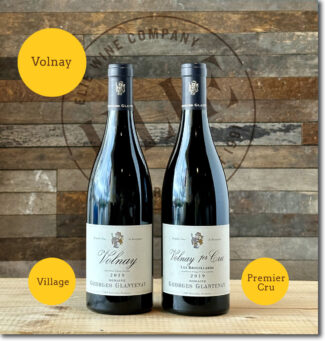 Domaine Georges, 2019 Glantenay Volnay ($54)
Domaine Georges, 2019 Glantenay Volnay ($54)
This Village-designated assemblage comes from multiple plots covering the appellation from north to south and located just below the Premier Crus, including Les Aussy, Les Petits Gamets, La Gigotte, Les Buttes, Robardelles, Les Grands Poisots, En Echards and Les Combes. Ripe raspberry and candied violet on the nose; a crisp and bracing wine styled as a fully modern Volnay, from bouquet to the fresh, crunchy finish.
Domaine Georges Glantenay, 2019 Volnay Premier Cru Les Brouillards ($99)
Brouillards is the domain’s flagship wine, and their largest Premier Cru holding. It is on the Pommard side of the village, to the north of Mitans and across the road from Les Angles. With about 25% whole-bunch fermentation, most of the vines date to 1950 (2 acres) and 1999 (3/4 acre). The wine is delineated and focused, and shows vibrant raspberry, black plum, sous-bois and a hint of allspice in a peppery finish.
$192 Aloxe-Corton Village vs. Premier Cru
The appellation of Aloxe-Corton stands guard near vinous gates of the Grand Crus of Corton and Corton-Charlemagne, enjoying (if not the prestige) many similar growing conditions, producing almost exclusively red wines known for both a depth of color and an intensity of flavor. With vines facing east, the terroir is soil driven, with flint and limestone rich in potassium and phosphoric acid lending supple firmness to the wines, especially those from the appellation’s southern end.
Whereas white wines from the region exist, they are rare. The deep soils are better suited for Pinot Noir; the terroir is a geological cradle for this prima donna varietal. At altitudes averaging 800, the vineyards are planted in reddish earth with flint and limestone debris known locally as ‘chaillots’ mixed in, and likewise rich in potassium and phosphoric acid. Such soils favors supple, highly-bred wines, while clay and marl breeds firmness and complexity. Anticipate wild berry notes that intensify with age and evolve into peony and jasmine, brandied fruits, pistachio, prune and truffle.
Domaine du Pavillon
Located south of Pommard, the Côte de Beaune’s Domaine du Pavillon is under the umbrella of the Bichot family, who settled in Burgundy in 1350. Albéric Bichot took over management in 1996, and although he fully respects traditions, he remains focused on the future, comparing himself to the ‘conductor of an orchestra, proud to bring people and their talents together over a common project.’
Among the talented people he has brought together is head winemaker Matthieu Mangenot who brings to Beaune a wealth of experience from estates in South Africa, Lebanon and Bordeaux. After his first experience in the Mâconnais/Beaujolais region, he joined Albert Bichot in 2007 as manager of Domaine Long-Depaquit in Chablis. His dual training as an agronomist and an oenologist allows him a comprehensive approach to winemaking, from vineyard management to bottling. His knowledge of soil formations and his pragmatic, transversal approach benefit the development of the House’s productions and pair well with its concern for authenticity and sustainability. “The wines of the Pavillon will bear the certified ‘organic wine’ label starting with vintage 2018,” he promises.
Viticulture is handled by Christophe Chauvel, assisted by Dominique Bon. Chauvel arrived in Burgundy in 1982 to study at Beaune’s viticultural secondary school, and after gaining experience under Sommelier Jean-Luc Pouteau at the restaurant Pavillon Elysée Lenôtre in Paris, he decided to go back to school to follow a 4-year winemaking program in Bordeaux. He joined the Albert Bichot estates in 1999.
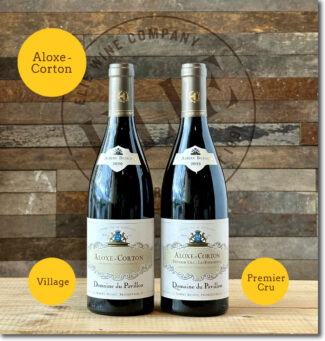 Domaine du Pavillon, 2020 Aloxe-Corton ($82)
Domaine du Pavillon, 2020 Aloxe-Corton ($82)
From the south end of Aloxe-Corton; the unlovely-sounding ‘Crapousuets’ is actually a one-acre lieu-dit that produces deeply serious Pinot Noir: This one shows a dark, ferrous nose with spiced cherry and cassis notes behind sweet damson and ripe, soft tannins. Only 3000 bottles made.
Domaine du Pavillon, 2020 Aloxe-Corton Premier Cru Fournières ($110)
From a one-acre plot on the eastern fringe of Aloxe-Corton at the base of the Corton hill, with some vines creeping up the lower slope. These 40-year-old vines are planted on scree overlying limestone. The name comes from the practice of clearing parcels by a burn-out process in stoves where the dried clods of kindling are called ‘fournières.’ The wine offers up a vibrant nose of ripe cherries and quintessential Corton spices with an appropriate touch of bonfire and supple tannins.
$288 Pommard Village vs. Premier Cru
The Pommard appellation covers only red wine, and as such, its renown is based on the lusciously ripe, deeply intense richness that Pinot Noir seems only able to achieve in Burgundy. With primarily mid-slope vineyards, Pommard boasts 28 Premier Crus which run almost uninterrupted from the commune boundaries of Beaune in the north to Volnay in the south. In fact, the only break in this belt of prized mid-slope vineyards is provided by the streets and houses of Pommard village itself.
Pommard’s terroir is somewhat typical of Burgundian red wine country. At the lower elevations, the soil is ancient alluvium, while mid-slope, the clay-limestone soils are well drained thanks to the inclusion of rock debris. Higher up are Jurassic (Oxfordian) marls, brown calcic soils, and brown limestone soils where in places, the soil is reddened by the presence of iron. Of the roughly 850 acres of vineyard, roughly one-third are Premier Cru, of which the most famous are Les Rugiens and Les Épenots.
Domaine de Courcel
Essentially built around Premier Cru sites, de Courcel’s 26 acres are peppered across Le Grand Clos des Épenots, Les Rugiens, Les Frémiers and Les Croix Noires. Le Grand Clos des Épenots, which accounts for 50% of the Domaine’s production, and Les Rugiens, are in a climat class of their own. The estate is currently managed by Gilles de Courcel, Anne Bommelaer and Marie de Courcel.
Marie is justifiably proud both of her family’s place in Burgundian history and the estate’s commitment to terroir and ecology: “We plough in such a way as to encourage intense biological activity, enabling the vines to better assimilate the minerals contained within the soil. The ploughing also helps the root of the vine penetrate deeper into the ground for a better expression. We optimize ripeness by pruning techniques, including de-budding and green harvesting in early August. We are after a delicate equilibrium in the fruit, and our final harvest is done relatively late so that the September sunshine increases the sugar intensity.”
Yves Confuron, de Courcel’s winemaker has always worked organically, believing that anything else would not be true to the expression of the site. Far from being a nod to the current fashion of biodynamics, it is an understanding each site must be treated naturally and maintained immaculately in order to wrest everything that it has to offer in a given vintage. He argues. “You cannot do this by picking anything but fruit as ripe as the vintage can make it, and that the whole bunches must go into the vat because that is all part of the origin.”
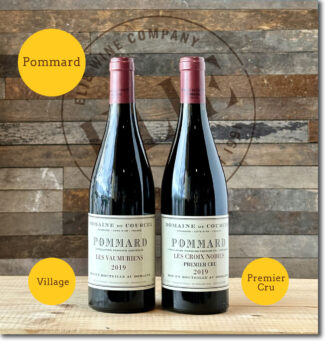 Domaine de Courcel, 2019 Pommard ‘Les Vaumuriens’ ($135)
Domaine de Courcel, 2019 Pommard ‘Les Vaumuriens’ ($135)
Pinot Noir from forty-year-old vines grown organically and planted on a 3.5-acre Village-level lieu-dit plot above the Premier Cru Les Rugiens. Vinification is done with whole bunches and cold maceration, and 21 months maturation in oak barrels, a third of which are new. Neither fined nor filtered. The wine shows rich black tea notes and herbs behind the dominant blackberry and black cherry profile.
Domaine de Courcel, 2019 Pommard Premier Cru Les Croix Noires ($153)
Les Croix Noires (‘The Black Crosses’) is a small Premier Cru vineyard entirely surrounded by other Premier Cru vineyards—Les Chaponnières lies on the slope above and to the west; Les Poutures and Les Bertins lie below and Les Frémiers to the south. Domaine de Courcel owns about half of it. Ripe red berries are in the forefront of this silken wine, shored up by warm earth and background nuances of humus and sweet flowers before concluding in a dusty, firmly structured finale.
Côte de Nuits
Terroir Lives Here
Named after its principal town, Nuits-St-Georges, the Côtes de Nuits produces the greatest red wines of Burgundy. As in its counterpart, the Côte de Beaune, not all the wines are created equal; the best are from a narrow, mid-slope band of limestone and from vineyards facing south-east to maximize exposure to the sun. This precise mix of soil and sunshine allows Pinot Noir to showcase an extraordinary range of textures and flavors.
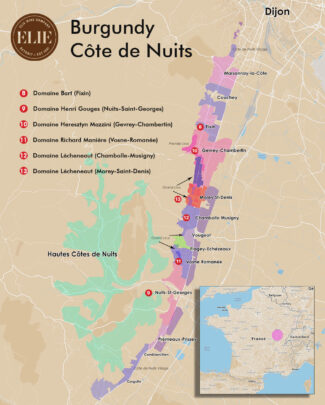
Côte de Nuits is subdivided into eight designated village; Chambolle-Musigny, Fixin, Gevrey-Chambertin, Marsannay (which also has a separate designation for rosé), Morey-Saint-Denis, Nuits-Saint-Georges, Vosne-Romanée and Vougeot. The area includes 24 superlative vineyard sites clustered around six communes and designated Grand Cru and over a hundred Premier Cru sites. In addition, there are two district appellations: Côte de Nuits-Villages, which are wonderfully elegant and affordable reds that are ready to drink upon release, and Bourgogne Hautes Côte de Nuits, which consists of some 20 villages in the hills west of the vineyards of the Côte de Nuits that produce wines with this appellation.
$198 Fixin Village vs. Premier Cru
Situated just north of Gevrey Chambertin—and often compared to it stylistically—Fixin is a small, predominantly Pinot Noir appellation whose wines are generally well-regarded. Along with its neighbor Marsannay, it is one of the most northerly appellations of the Côte de Nuits, covering roughly 250 acres of vineyards spread evenly between Fixin itself and its southern neighbor, Brochon.
There is a group of vineyards on the slopes immediately above Fixin where the terrain rises quite rapidly from 950 to 1150 feet, providing relatively steep, well-drained sites with the limestone-rich soils so characteristic of classic Burgundy. In this region, six Fixin Premier Cru sites are found, most of them located around the western side of Fixin village itself.
Domaine Bart
Sixteen years ago, the winegrowers of Marsannay started the process of having part of the appellation upgraded to Premier Cru. At Domaine Bart, which produces as many as nine different Marsannay bottlings in a given vintage, it is believed that 25% and 30% of the appellation is up for this bump upstairs. Pierre Bart, the sixth generation to run Domaine Bart, says, “We are trying to show which climats would be of interest and which ones should remain in the village appellation. My guess is that there will be five or six Premier Crus. probably the largest ones like Champs Perdrix, Champ Salomon, Clos du Roi, Longeroies and Montagne.”
The Bart domain covers 54 acres, mostly in Marsannay, but with a few parcels in Fixin, Gevrey-Chambertin, Chambolle-Musigny and Santenay.
“My grandmother comes from the same family as Domaine Bruno Clair,” explains Pierre Bart. “Part of the vines come from that side of the family, part from my grandfather’s side. The Bonnes-Mares and the Chambertin-Clos de Bèze mainly come from my grandmother. 35 years ago, when my uncle arrived at the domain, the style of the wines changed. He increased the size of the holding, mainly in Marsannay. He chose to improve quality, both in terms of equipment and in winemaking. Since then we haven’t changed our vision a single iota.”
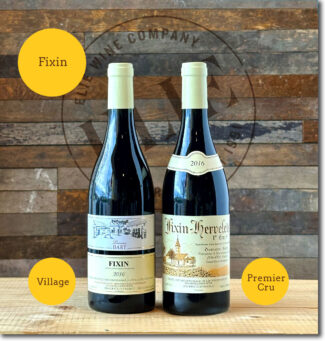 Domaine Bart, 2016 Fixin ($88)
Domaine Bart, 2016 Fixin ($88)
Dark raspberry, sour cherry and dried herbs and the characteristic woodsy ‘sous bois’ lift this wine which has found its stride after several years of impeccable bottle aging.
Domaine Bart, 2016 Fixin Premier Cru Hervelets ($110)
Among Fixin’s Premier Cru vineyards—Clos de la Perrière, Clos du Chapitre, Arvelets, Clos Napoléon, Le Meix Bas and Hervelets, Hervelets is known to produce heavier and longer-lived reds This one is spicy, revealing sandalwood, sweet baking spices and light pepper aromas framing cherry and raspberry, with a soft dusting of tannins on the finish.
$207 Nuits-Saint-Georges Village vs. Premier Cru
With the village of Nuits-St-Georges itself as the fulcrum, the robust appellation extends to the north as far as the border of Vosne-Romanée, while the southern section lies partly in Nuits-Saint-Georges and partly in Prémeaux. The wines from each section are unique in style and according to experts, with differences defined (in the main) by the lay of the land. The soils in the northern sector are built around the pebbly alluvium that washes down from up-slope, or in the low-lying parts, around silty deposits from the river Meuzin. In the southern sector the alluvia at the base of the slopes originate in the combe of Vallerots where there are deep marly-limestone soils, while at the top of the slope, the soil has nearly all eroded away and the rock is near the surface. In both regions, favored exposures are mostly to the east or southeast.
Producing predominantly red wine, Nuit-Saint-George bottles display the muscularity and breeding most sought after in Burgundy—the ability to improve with bottle age. When young, the wine display aromas of cherry, strawberry and blackcurrant, and when matured, leather, truffle, fur and game.
Domaine Henri Gouges
Considered by many to be Nuits-Saint-Georges’ top domain, the estate has been passed down through many generations and is, to this day, a family affair, with four Gouges at the helm.
Grégory Gouges has been the domain’s winemaker since 2003; Pierre today runs the business end with his cousin Christian, son Grégory, and Grégory’s cousin Antoine. The vineyards cover 36 acres, including seven of the best well-positioned Premier Crus: Les Chaignots, Chene Carteau, Les Pruliers, the monopole vineyard of Clos des Porrets-Saint-Georges and nearly three acres each of each of the appellation’s most famous vineyards, Les Vaucrains and Les Saint Georges.
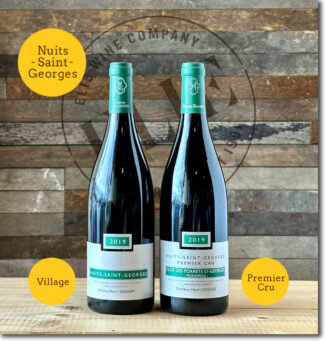 Maison Henri Gouges, 2019 Nuits-Saint-Georges ($81)
Maison Henri Gouges, 2019 Nuits-Saint-Georges ($81)
Domaine Henri Gouges makes this outstanding Nuits-Saint-Georges by blending estate fruit with neighboring organic vineyards and bottles it under ‘Maison’ Henri Gouges. A nose of wild blackberry drives the wine, which shows a touch of herb and musk that should become more pronounced with a bit of age.
Domaine Henri Gouges Nuits-Saint-Georges, 2019 Premier Cru Clos des Porrets St-Georges ‘Monopole’ ($126)
Clos de Porrets is a nine-acre lieu-dit within the wider Les Porrets Premier Cru; it is comprised of deep, stony soils with a good amount of clay covering a hard, limestone base that allows for plentiful drainage. Somewhat unique, beside Pinot Noir, the vineyard also contains a variety named for Henri Gouges. Pinot Gouges is a white-skinned mutation of the notoriously unstable red cultivar. The wine shows strawberry and rich black plum, and is brightly acidic behind a layered, dense texture. A wonderful wine for the long haul.
$238 Gevrey-Chambertin Village vs. Premier Cru
As those schooled in Burgundian lore know, during the nineteenth century it became fashionable for villages in the Côte d’Or to adopt double-barreled names, adding a hyphen followed by the name of their most famous vineyard: Thus Chambolle added Musigny and Gevrey added Chambertin.
In minimalism, less may be more, and in wine—especially those with a hyphenated name—more may be less; a village-level Gevrey-Chambertin, for example, does not seek to compete with the quality of ‘Le Chambertin’ itself. But if nothing else, its name reminds you that it comes from a rarefied zip code. And to be sure, the region is hallowed grapeland, graced with the Holy Trinity of terroir—elevation, climate and soil structure. Contained within the appellation are nine Grand Crus and 26 Premier Crus (whose name on the label may be followed by the name of the climat of origin) as well as well as nearly a thousand acres of Village wine.
Domaine Heresztyn Mazzini
Florence and Simon Heresztyn-Mazzini hail from different winemaking regions—Florence from Burgundy and Simon from Champagne. After ten years of working Heresztyn-owned vineyards in Gevrey-Chambertin, the couple decided to start their own venture on 14 acres spread across the villages of Gevrey-Chambertin, Morey-Saint-Denis, and Chambolle-Musigny. 2012 was their first vintage.
Florence maintains, “We are closely attached to the Côte de Nuits and its unique terroirs and work relentless to bring out the region’s best qualities. Simon and I make it a point of personal pride to respect the region’s soils and natural environment.
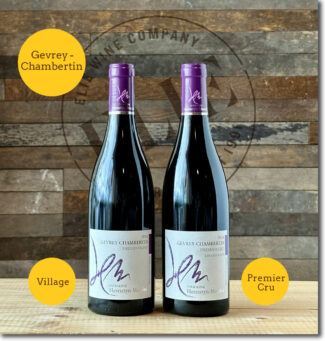 Domaine Heresztyn Mazzini ‘Vieilles Vignes’, 2016 Gevrey-Chambertin ($89)
Domaine Heresztyn Mazzini ‘Vieilles Vignes’, 2016 Gevrey-Chambertin ($89)
Using grapes taken exclusively from older vines, team Heresztyn-Mazzini relies on 35% whole bunch with wild yeast fermentation, then pre-ferments using cold maceration. Punch downs take place three to four times a day, and the wine is aged in 30% new wood oak barrels for 16-18 months, then bottled at the estate without fining or filtering.
Domaine Heresztyn Mazzini, 2016 Gevrey-Chambertin Premier Cru Goulots ($140)
Les Goulots is a five-acre Premier Cru climat at the northern end of the Gevrey-Chambertin vineyard; it is one of the most elevated sites in the Côte de Nuits, and is planted entirely to Pinot Noir. the steep vineyards on the edge of the Côte d’Or face almost due east, giving vines an exposure that is quite different to the climats further south. Les Goulots shares this characteristic, and the mesoclimate here is much cooler, as shade comes to the vineyard much earlier in the day than in the south-facing vineyards directly west of Gevrey-Chambertin village, including the famed Clos Saint-Jacques vineyard. The wine is tight and focused, glossy quality, showing cool red fruit on the palate and a long finish with nice tannin support, both from the grapes and the oak.
$270 Vosne-Romanée Village vs. Premier Cru
Originally named just Vosne, the village took the suffix Romanée in 1866 in honor of its most prized vineyard, La Romanée—a habit of many Burgundy communes of the era. From the perspective of a wine lover, it may be grouped together with neighboring Flagey-Echézeaux; while the villages are entirely separate, their finest vineyards are clustered together immediately north of Vosne-Romanée and take that latter title.
The entire surface area of Vosne-Romanée Grand Crus vineyards (excluding Flagey-Echézeaux) is 67 acres, about half the size of the single Clos de Vougeot climat just across the commune boundary. Even so, the commune of Flagey-Echézeaux with the Echézeaux and Grands-Echézeaux sites included, has more Grand Cru surface area than the Premier Crus and Villages combined. Vosne-Romanée is divided between six individual climats—La Grande Rue, La Tâche, Richebourg, La Romanée, Romanée-Saint-Vivant and the most famous, Romanée-Conti. The best vineyards lie on the mid-slope of the Côte d’Or escarpment. Around these prestigious sites are dotted the Premier Cru vineyards and some entirely unclassified land—the difference between a Grand Cru vine and one deemed worthy only of the regional Bourgogne appellation is sometimes a matter of a few feet.
Domaine Richard Manière
Domaine Manière, located in the heart of Vosne Romanée, has been managed by the Manière family for three generations. Richard Manière (a former rugby player) now owns the 20 acre vineyard, having taken over from his parents in 1998.
With plots from Nuits-Saint-Georges to Fixin in the north of the Côte de Nuits, Vosne-Romanée is the flagship appellation represented in Richard’s portfolio. He farms . Richard’s vineyards are farmed using the ‘lutte raisonnée’ method, with manual soil tillage, 100% manual harvesting and traditional Burgundian vinification.
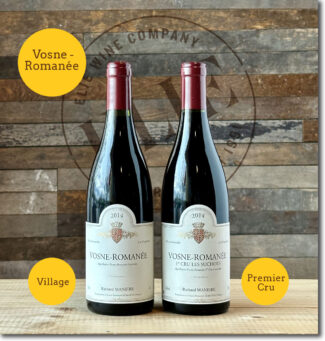 Domaine Richard Manière, 2014 Vosne-Romanée ($110)
Domaine Richard Manière, 2014 Vosne-Romanée ($110)
A beautiful expression of Vosne’s characteristic smoky aromas, with raspberry, mocha and roast coffee leading to a sweet-tannin finish and good length.
Domaine Richard Manière, 2014 Vosne-Romanée Premier Cru Les Suchots ($160)
Planted entirely to Pinot Noir, Les Suchots is the largest Premier Cru climat in Vosne-Romanée; the vineyard separates Echézeaux and Romanée-Saint-Vivant. The 32 acre vineyard sits along the northern border of the Vosne-Romanée commune, although this is something of an academic distinction given that vineyards on the other side of this administrative line in Flagey-Echézeaux adopt the Vosne-Romanée name by convention. The wine is ethereal, showing the mature edge of dried cherry, mushroom, umami and spice.
$339 Chambolle-Musigny Village vs. Premier Cru
Along with Vosne-Romanée, the communes of Chambolle-Musigny and Gevrey-Chambertin round out the ‘Big Three’ of Burgundy reds. Much has been written to compare the last two, perhaps best summarized by Nadine Gublin of Domaine Jacques Prieur: “Chambertin has a colder climate and tends to have more structure than Musigny; Musigny is more forward and elegant; it has a body that is very silky and satiny, while Chambertin has greater finesse, but needs more time to reveal itself—it is more serious and discreet.”
There is a marked difference in size, too: Chambolle-Musigny is relatively small, covering five hundred acres, of which 180 are Premier Cru—the appellation has 24. There are also two Grand Cru climats, Bonnes-Mares, which links its vineyards to those of Morey-Saint-Denis, and Musigny, overlooking the Clos de Vougeot. The prestigious Premier Cru site Les Amoureuses, however, is doubtless on their level.
Domaine Lécheneaut
Having been founded in the 1950s by Fernand Lécheneaut, the domain launched modestly, with five acres of vineyard in Nuits-Saint-Georges, Chambolle-Musigny and Morey-Saint-Denis. During these early years, Lécheneaut sold bulk wine to négociants, but in 1985, his sons Philippe and Vincent took over and brought with them an expanded vision. They grew their vineyard holdings while they began to bottle at the estate. The new Lécheneaut plots, including several Premier Cru vineyards in Chambolle-Musigny and Gevrey-Chambertin, speckle the map of the Côte de Nuits from north to south, but judiciously—many of the holdings are under an acre. With vines in 23 appellations, the total land under their management is around thirty acres.
As the Lécheneaut brothers approach retirement, Vincent’s son Jules has joined the team with a view toward combining lessons learned in his experiences working vines in Oregon with the exceptional terroir his family nurtures.
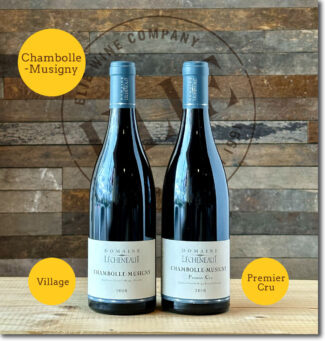 Domaine Lécheneaut, 2018 Chambolle-Musigny ($126)
Domaine Lécheneaut, 2018 Chambolle-Musigny ($126)
From a single acre site of 63-year-old vines across several Villages-level lieux-dits, Chardannes, Herbues, Maladières and Babillère. Most feature thin bedrock soils where cracks in the limestone encourage root exploration, and ensure a marvelous complexity. The bouquet of violets and rose petals introduces a wine which is beginning to age into spicy maturity with prunes and truffles and a palate that has evolved with rich, silken tannins. 2400 bottles made.
Domaine Lécheneaut, 2018 Chambolle-Musigny Premier Cru ($216)
A tiny plot (smaller than a quarter-acre) of 70-year-old vines in ‘Les Plantes’ and ‘Les Borniques.’ These lieux-dits are located on the alluvial cone of the Ambin valley and the substratum is composed of Periglacial red silt enriched with breccias of the Bathonian limestone that forms the plateau. Sophisticated and elegant, the wine presents rich aromas of blackberry, blueberry, redcurrant and ripe plum which over time should develop into leather, chocolate and pepper notes. 1000 bottles made.
$270 Morey-Saint-Denis Village vs. Premier Cru
Forming a stylistic bridge between the firm, fleshy wines of Gevrey-Chambertin and the perfumed wines of Chambolle-Musigny, Morey-Saint-Denis is a wealth of Crus, including twenty Premier Crus and five Grand Crus: Clos de Tart, Bonnes-Mares, Clos de la Roche, Clos Saint-Denis and Clos des Lambrays. The best sites are planted on thin, well-drained, oolitic limestone soils that date from the Middle Jurassic, and occupy the middle slopes while lesser quality wines are produced on the highest and lowest elevations.
Even among Burgundy enthusiast, the Premier Cru climats are sometimes unfamiliar, due in part to the practice of blending several vineyards as a generic Morey-Saint-Denis Premier Cru bottling, something that is somewhat more common here than in other communes.
Domaine Lécheneaut, 2018 Morey-Saint-Denis ($126)
A textbook Morey-Saint-Denis blend of parcels from Pierres Virants, En Seuvrey, Les Cognées and Les Porroux, where the vines are rooted in limestone and chalky-clay soils from the Jurassic period; Bathonien white oolite on the top of the hill and Bajocien chalk on the downslope. The wine is rich and assertive with Gevrey-Chambertin’s muscle and Chambolle-Musigny’s grace—its tone is suggestive of tart cherries, rose hips, violets and walnuts and fills out with stony persistence.
Domaine Jean-Michel Guillon & Fils
Local boy makes good’ is a common enough tale in Burgundy, where land—which can command a price tag twice that of Bordeaux—is generally held by families. Most success stories involve inheriting it or marrying it. Rare is the breakthrough of an outsider who can, for example, step off a train in Gevrey-Chambertin without connections or formal wine training and forge a Burgundian empire within an enclave already pretty imperialistic.
Enter Jean-Michel Guillon. Born into a military tradition, Jean-Michel Guillon chose to settle in France after his past service in the Polynesian Islands and in 1980, without much formal training, planted grapes on five acres of land. What began as a nascent fascination grew into an overarching passion, and the estate today covers nearly forty acres spread over more than 20 appellations. It is work that, like the best Gevrey-Chambertin wines, took years to peak, both stylistically and critically: 2020 turned out to be Jean-Michel Guillon’s best vintage ever.
He explains: “It is all the result of my love for this land, and any acclaim I have received is based on innovative production processes and more importantly, taking into account the ecological needs of the vine. The climate crisis and the scarcity of natural materials is taken very seriously at the winery. Global warming is at the heart of the destruction of habitat destruction and the appearance of certain diseases. In order to facilitate cultivation and harvesting, we have worked diligently worked to reduce our carbon footprint by using phytosanitary products that respect the environment.”
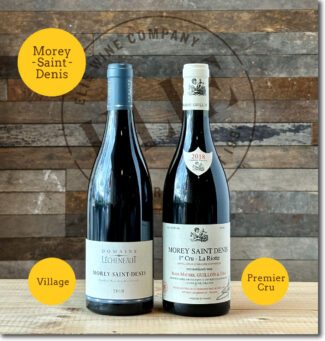 Domaine Jean-Michel Guillon & Fils, 2018 Morey-Saint-Denis Premier Cru La Riotte ($144)
Domaine Jean-Michel Guillon & Fils, 2018 Morey-Saint-Denis Premier Cru La Riotte ($144)
La Riotte is one of 20 Premier Cru climats in the center of tiny Morey-Saint-Denis, and like most of the others, it is planted entirely to Pinot Noir. The six-acre vineyard runs alongside one of the roads running east, out of the village of Morey and down the slope towards the road that runs the length of the Côte d’Or vineyards, and the name is believed to be a corruption of la ruotte—‘the road.’ Riotte’s terroir is built around limestone-based soils containing a good proportion of clay in the soil, which stores sufficient water to keep vines hydrated without being excessive. The wine shows classic Morey-Saint-Denis structure, being medium-bodied and complex with a floral, spice-inflected nose and a chiseled, red-fruit palate.
A Gift That Keeps On Giving
Membership To ‘The Champagne Society’
Bimonthly Subscription
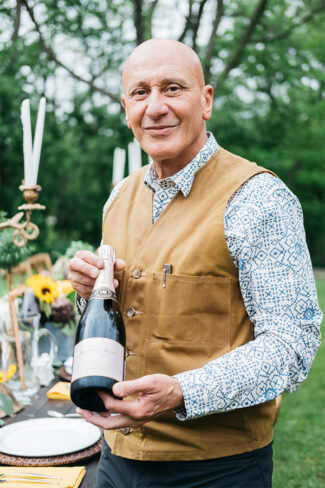 Not only is Champagne the quintessential drink of celebration, it has traditionally been a gift given with ramped-up sentiments. This year we are offering a couple of variations on this theme, beginning with an opportunity to gift a special someone a six-month or twelve-month membership to The Champagne Society. Our pick for December will be packaged in a wrap-ready gift box along with a congratulatory certificate explaining what lies ahead in bi-monthly installments. For more information please visit our website page: A Holiday Gift: ‘The Champagne Society’ Membership 6-Month ($299) or 12-Month ($589) Subscription.
Not only is Champagne the quintessential drink of celebration, it has traditionally been a gift given with ramped-up sentiments. This year we are offering a couple of variations on this theme, beginning with an opportunity to gift a special someone a six-month or twelve-month membership to The Champagne Society. Our pick for December will be packaged in a wrap-ready gift box along with a congratulatory certificate explaining what lies ahead in bi-monthly installments. For more information please visit our website page: A Holiday Gift: ‘The Champagne Society’ Membership 6-Month ($299) or 12-Month ($589) Subscription.
Vintage Journal
2020 – Classical And Age Worthy
François Labet, a négociant whose family has lived in Beaune for 300 years, summarizes the 2020 vintage like this: “An intellectually-challenging vintage; the reds in particular defy easy categorization because the impact of that season varied considerably by terroir. Producers had key decisions to make, especially when to pick and that significantly affected both the style and quality of the resulting wines.
And this is because the most notable feature of this vintage was its early and rapid harvest: Many domains began picking the week of August 17th and while August harvests have been frequent in the 21st century (there were none in the prior century), this was for many domains the first time they had not only started, but completed a harvest before the end of August.
The resulting wines (particularly from earlier harvests where sugars were high and acids intact) are remarkable, both for whites and reds. The season was hot and dry, but water tables were healthy from the mild and wet preceding winter.
Beaune was particularly fortunate and Chef de Cave Frédéric Weber (Bouchard Pere et Fils) describes 2020 as a concentrated and strong vintage: “It reminds me of 2016 for its vibrancy and energy; the wines are voluptuous and structured. A great vintage for the future, like the ‘18s.
2019 – Concentrated And Vibrant
2019 is a vintage that had already generated excitement in Burgundy by harvest-time, and the accolades have grown since. The winter was extremely mild, but the spring was chilly, with April frosts cutting yields, especially in the Mâconnais. Flowering was uneven due to a cooler than average June and some bunches suffered from millerandage, further cutting yields. Temperatures then warmed up rapidly, so that surviving grapes were highly concentrated and produced a small but brilliant vintage, well-balanced and with great potential. The red wines carry a particular punch, classic in style, but with rich fruit and structure promising a broad drinking window.
2018 – Powerful, Voluptuous With Immediate Appeal
Calescent and copious—big words to describe a big vintage, equally fascinating and enjoyable for those who like potent, youthful Pinots and for those willing to wait out a prolonged span of aging. A hot, dry summer generally requires a wet preceding winter to top up groundwater reserves, and 2017/18 was just that. Conditions warmed up in time for a beautiful early flowering—another requirement for a bountiful harvest. The summer, as indicated, was hot and dry, although the farther north you went, sporadic rainfall was welcomed. The only anomaly during the season was hail in Nuits St Georges; two storms striking the south of the village and Prémeaux-Prissey at the end of June and the beginning of July, wiping out as much as 40% of the crop in some vineyards. Due to the heat, the picking window for Pinot Noir was short, as levels for sugars, acids and phenolics rose quickly and called for an early harvest.
2016 – Supple And Accessible
A classic vintage in which the best producers seized victory from the jaws of defeat. In general, the harvest was extremely small (for some it was the tiniest on record) but the grapes that survived the year’s barrage of frosts, rot and heat were generally of exceptionally high quality, renowned for producing wines with balance and poise. The reds, in particular, are rich, ripe; the whites suffered the most, with many producers being hit so badly that releasing a wine became impossible. Overall, what was made in the 2016 vintage tends to be very good, even excellent, but extremely limited quantities means that prices may be on the high side.
2014 – Classic Burgundy, Very Pleasing Reds
Whereas 2014 failed to provide enough showstopper wines to make it legendary, it remains and concentrated and well-structured vintage that rates as excellent. Although much of the summer was lukewarm and drizzly, there were heat spikes and dry spells that, by September, allowed for a leisurely harvest. Work in the cellar separated those bunches affected by damp-weather rot and although yields were lower than normal, quality was high—especially among the reds, which have the character for long-term aging.
- - -
Posted on 2023.12.15 in Chambolle-Musigny, Savigny-lès-Beaune, Monthélie, Aloxe-Corton, Auxey-Duresses, Morey-Saint-Denis, Maranges, Nuits-Saint-Georges, Santenay, Vosne-Romanée, Pommard, Volnay, Gevrey-Chambertin, France, Burgundy, Wine-Aid Packages
Featured Wines
- Notebook: A’Boudt Town
- Saturday Sips Wines
- Saturday Sips Review Club
- The Champagne Society
- Wine-Aid Packages
Wine Regions
Grape Varieties
Aglianico, Albarino, Albarín Blanco, Albarín Tinto, Albillo, Aleatico, Arbanne, Aubun, Barbarossa, barbera, Beaune, Biancu Gentile, bourboulenc, Cabernet Franc, Cabernet Sauvignon, Caino, Caladoc, Calvi, Carcajolu-Neru, Carignan, Chablis, Chardonnay, Chasselas, Clairette, Corvina, Cot, Counoise, Erbamat, Ferrol, Fiano, Frappato, Friulano, Fromenteau, Fumin, Garnacha, Gewurztraminer, Godello, Graciano, Grenache, Grolleau, Groppello, Juan Garcia, Lambrusco, Loureira, Macabeo, Macabou, Malvasia, Malvasia Nera, Marsanne, Marselan, Marzemino, Melon de Bourgogne, Merlot, Mondeuse, Montanaccia, Montepulciano, Morescola, Morescono, Moscatell, Muscadelle, Muscat, Natural, Nero d'Avola, Parellada, Patrimonio, Petit Meslier, Petit Verdot, Pineau d'Aunis, Pinot Auxerrois, Pinot Blanc, Pinot Gris, Pinot Meunier, Pinot Noir, Poulsard, Prieto Picudo, Rondinella, Rousanne, Roussanne, Sangiovese, Sauvignon Blanc, Savignin, Semillon, Souson, Sparkling, Sumoll, Sylvaner, Syrah, Tannat, Tempranillo, Trebbiano, Trebbiano Valtenesi, Treixadura, Trousseau, Ugni Blanc, vaccarèse, Verdicchio, Vermentino, Viognier, Viura, Xarel-loWines & Events by Date
- April 2024
- March 2024
- February 2024
- January 2024
- December 2023
- November 2023
- October 2023
- September 2023
- August 2023
- July 2023
- June 2023
- May 2023
- April 2023
- March 2023
- February 2023
- January 2023
- December 2022
- November 2022
- October 2022
- September 2022
- August 2022
- July 2022
- June 2022
- May 2022
- April 2022
- March 2022
- February 2022
- January 2022
- December 2021
- November 2021
- October 2021
- September 2021
- August 2021
- July 2021
- June 2021
- May 2021
- April 2021
- March 2021
- February 2021
- January 2021
- December 2020
- November 2020
- October 2020
- September 2020
- August 2020
- July 2020
- June 2020
- May 2020
- April 2020
- March 2020
- February 2020
- January 2020
- December 2019
- November 2019
- October 2019
- September 2019
- August 2019
- July 2019
- June 2019
- May 2019
- April 2019
- March 2019
- February 2019
- January 2019
- December 2018
- November 2018
- October 2018
- September 2018
- August 2018
- July 2018
- June 2018
- May 2018
- April 2018
- March 2018
- February 2018
- January 2018
- December 2017
- November 2017
- October 2017
- September 2017
- August 2017
- July 2017
- June 2017
- May 2017
- April 2017
- March 2017
- February 2017
- January 2017
- December 2016
- November 2016
- October 2016
- September 2016
- August 2016
- July 2016
- June 2016
- May 2016
- April 2016
- March 2016
- February 2016
- January 2016
- December 2015
- November 2015
- October 2015
- September 2015
- August 2015
- July 2015
- June 2015
- May 2015
- April 2015
- March 2015
- February 2015
- January 2015
- December 2014
- November 2014
- October 2014
- September 2014
- August 2014
- July 2014
- June 2014
- April 2014
- March 2014
- February 2014
- January 2014
- December 2013
- November 2013
- October 2013
- September 2013
- August 2013
- July 2013
- June 2013
- May 2013
- April 2013
- March 2013
- February 2013
- January 2013
- December 2012
- November 2012
- October 2012
- February 2004
Search



